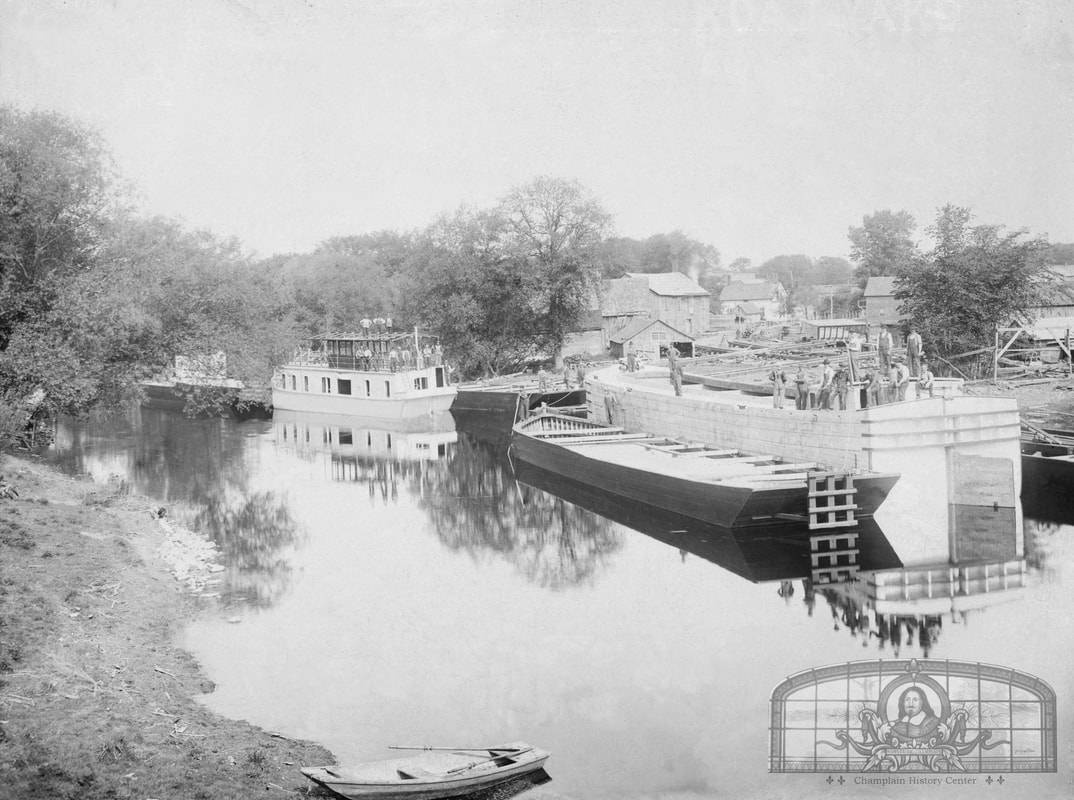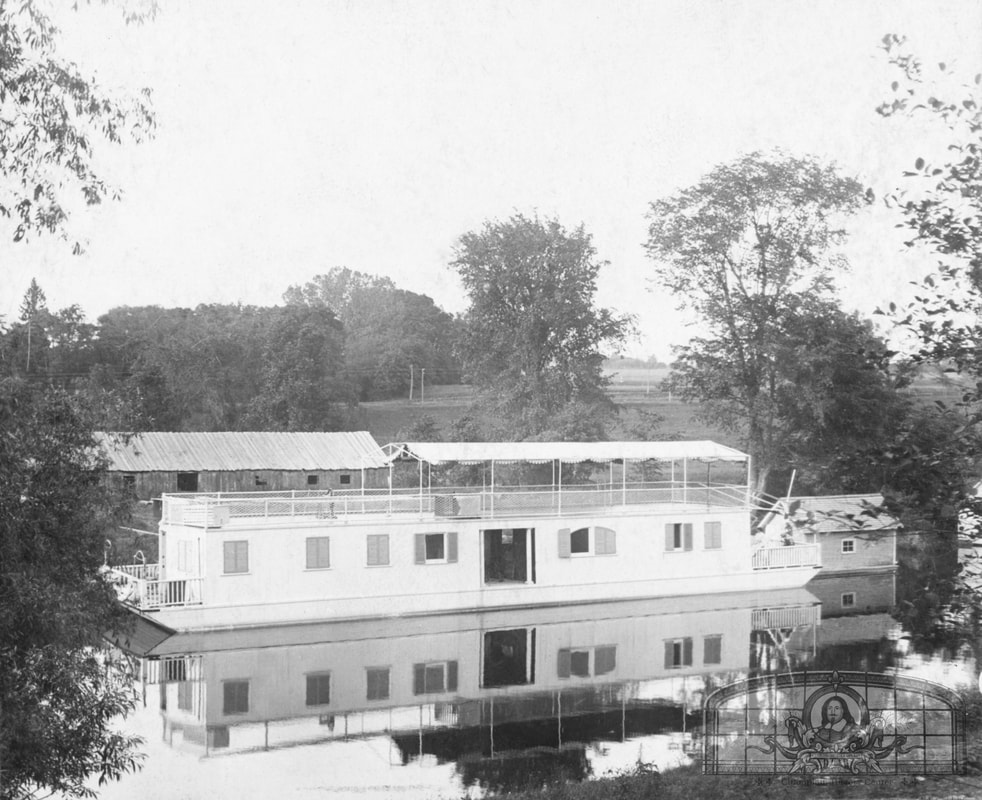Champlain’s biggest boat yard is shown with a houseboat and canal boat under construction. A barge is moored next to the canal boat. This is one of the best photos seen of this boat yard which was probably at the end of Gokey Road. Behind the boats were numerous buildings that were used for tools and storage. Piles of lumber lay near the boats as well as the partial hull of a future canal boat. Today, there is no trace of any of these buildings.
The Canal Boat Industry in the Village of Champlain
Adapted from the 2014 Champlain Historic Calendar series (click link)
The Great Chazy River has been a tremendous economic engine for the village and town of Champlain. The river winds its way from Upper Chateauguay Lake and Chazy Lake and passes through the town of Mooers and then into the town of Champlain. Boat building in Champlain grew over the years and then accelerated in the 1880s before peaking out around 1910. Champlain Town was known as one of Lake Champlain’s most important boat building locations.
The Town of Champlain had at least three boat yards on the Great Chazy River that were used by various partners over a period of 100 years. The largest boat yard was south of the village of Champlain at the end of today’s Gokey Road. This boat yard was built by Royal C. Moore and Timothy Hoyle and was shown as “Moore & Hoyle’s Wharves” on a 1857 map. The second major boat yard was in the Village of Champlain at the end of River Street. This yard was probably first used by the Nyes to build several boats and heavily used starting in 1879 and known as “Kellogg & Averill’s boat yard.” The former “Moore and Hoyle” boat yard and wharves were probably owned by them too. Boat building also occurred at the mouth of the Chazy river on the southern bank. Smaller boat yards were surely built along the river by independent boat builders.
With an abundant supply of water and gentle slope, the river was used to float timber to downstream sawmills where they were sawed and placed on sloops and canal boats near the Rapids. By 1862, 20 million feet of lumber was shipped from Champlain to ports in St. Johns or Whitehall for use in house building or to power the steamers on the lake. The need for sturdy boats prompted Champlain’s early industrialists to build their own.
The boat yards in Champlain built many luxury yachts and houseboats as well as canal boats and barges for commercial use. Newspaper articles described the many boats built here: “Kellogg and Averill have recently launched at their yard in Champlain a steam yacht for J.G. Saunders, which was christened ‘Nellie F’. She was planned for fishing service and seaworthiness, and will be quite an addition to Mr. Saunders’ fleet of steam yachts now on Lake Champlain” [1885]; “James Averill, Jr., of Champlain, is building for himself a fine steam yacht, 44 feet in length, to be schooner-rigged, which it is expected will be one of the finest on Lake Champlain” [1886]; “Two large barges are in process of construction at Champlain. Also, a handsome steam pleasure yacht is being built for Joseph and Louis LaFountain for use on Lake Champlain next season” [1893]; “The sailing vessel building at Averill’s boat yard will be launched in a few days” [1903]; “The Johnson houseboat ‘Winona’ which has been in the course of construction for the past three months at the Averill and Clark boatyard, left under its own power for Plattsburgh Friday afternoon” [1909]; “Hon. N.W. Fisk’s yacht, ‘Pauline’ is undergoing repairs at Averill and Clark’s boatyard.” [1909]
The trade between the US and Canada on the Lake Champlain-Richelieu River waterway prompted the Quebec government to build the 12 mile Chambly Canal to bypass the rapids on the Richelieu River. Since the time of Samuel de Champlain’s expedition to Lake Champlain in 1609, the rapids here prevented direct passage between Lake Champlain and the St. Lawrence River. The six foot deep canal was started in 1831 and opened in 1843. Previous to that, the 60 mile Champlain Canal near Whitehall, NY, had opened in 1823 and connected Lake Champlain to the Hudson River. With the two canals opened, goods could be transported from the St. Lawrence River to New York City and to all ports in-between. This opened up markets as far away as Quebec City, Ottawa and New York City. Rouses Point became an important customs port for the import of goods from Canada and several docks were built to house the customs houses there. In 1860, the “F.W. Myers” company in Rouses Point was established to handle the customs brokerage business which insured that all import duties were paid by the shippers.
The Moore, Nye, Hoyle and Whiteside families were some of Champlain’s earliest industrialists. They operated sawmills, gristmills, owned commercial farms and made many finished products. They needed a good supply of boats to move raw materials to their mills and finished products to market. The earliest commercial boat building project probably dates to 1838. Freeman and Bartlett Nye were merchants and needed boats to ship their products to market. In 1838, they built the schooner “Champlain” and Captain George Brown sailed it between Champlain and Whitehall (an 1841 receipt shows that it transferred supplies at Point au Roche). It is possible the Nyes built the boat on land they owned on the north bank of the river at the end of River Street (the site of the sewage treatment plant today). Bartlett Nye owned the property across the street where his Locust Hill house was built in 1851 (the future Savoy) and his property extended down to the north bank of the river. Not coincidentally, this area became Kellogg and Averill’s boat yard in 1879 and Bill Earl had a boat launch here circa 1909.
In 1839, the Nyes built the schooner “General Scott” and named it after General Winfield Scott who had visited Champlain that previous year during the rebellion in Canada. The boat was 80 feet in length, 26 feet wide and 5 feet deep and the tonnage was 101 which made it the largest schooner on the lake at the time. Captain Brown was in command of the boat for 13 years and owned a farm on the lakeshore in Chazy. Afterwards, in 1853, Captain Stoughton was at the helm. Note the two shipping receipts of Brown and Stoughton. On August 2, 1847, Freeman Nye wrote a letter to B. Flanders to have the Scott’s sails replaced in Whitehall. The sails could be made of No. 1 or No. 2 cotton but the pricing was different.
The “General Scott” was used to transport commodities to St. Johns and Whitehall. The Whitehall consignees were “Travis and Co.” and the “Northern Transportation Line.” Many receipts show hundreds of thousands of pine and hemlock boards shipped to Whitehall and then shipped to Troy, NY. Pearl ash (a refined type of potash) was also shipped as well as wall strips, clap boards, plaster, rope, mill saws, barrels of oil, reams of paper, glass and sugar. On November 21, 1849, the steamer “Ethan Allen” charged $6 and $4 for towing the “Gen. Scott” on two occasions and other boats towed it too. By April of 1860, after 21 years of use, Freeman Nye was contemplating selling the boat. Mr. H.J. Hinckley, of Essex, NY, had expressed an interest but other people were interested in it too. Freeman wrote to himself that he wanted $2,000 but would settle for $1,000. Interestingly, Mr. Hinckley had been the captain of the boat “Isaac Nye” in Burlington which had been built in Essex in 1848 under the original name of “Sea Slipper”. The boat was owned by Joe Bradley and Thomas H. Canfield and was named after Freeman’s brother Isaac who lived in Burlington and owned a store on Battery Street. Today the former Isaac Nye store is the ‘Shanty on the Shore’ restaurant and behind it was Nye Dock which was later renamed to King Street Dock after it was expanded into the lake. Isaac Nye’s ghost is supposed to haunt the building (or so some people say). It is not known who Freeman Nye sold the “Isaac Nye” to, but it was reportedly surrendered in Burlington in 1872 and abandoned.
Champlain’s canal boats and barges played a prominent role in the 1909 Tercentenary celebrations. Boat builder James Averill conceived of tying together six barges to create a floating exhibit. Starting in February of 1909, he corresponded with L. Armstrong of the Canadian-Pacific Railway in Montreal who was appointed to work with Averill on the exhibit. The budget for the exhibit was $12,000 and an expense list shows the costs of the supplies to make the props (30,000 feet of spruce flooring, Oregon pine, oak timber, spikes, rope, bales of cotton, 125 pounds of white lead, canvass for the painted backdrop, etc.). An elaborate native village was designed and built on the barges and 200 natives from Canada put on a pageant in front of waterfront crowds in Burlington, Isle la Motte, Plattsburgh, Crown Point and Rouses Point. Some of the correspondence centered around taking the barges down to New York City for the Hudson celebrations. An April 1909 newspaper article described the floating pageant: “…Two hundred Indians will be used in the pageant and the marine stage will be built upon six barges which are already under construction at the boat yard of Averill & Clark at Champlain. These barges will be joined together by platforms, making a craft resembling a catamaran. The whole will be transferred into a floating island with rocks, trees, Iroquois log-houses, lodges, etc.” A year after the celebrations Tercentenary committee member Walter Witherbee advertised the barges and told Averill he had a number of inquiries.


